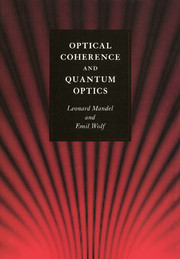Book contents
- Frontmatter
- Contents
- Preface
- 1 Elements of probability theory
- 2 Random (or stochastic) processes
- 3 Some useful mathematical techniques
- 4 Second-order coherence theory of scalar wavefields
- 5 Radiation from sources of any state of coherence
- 6 Second-order coherence theory of vector electromagnetic fields
- 7 Some applications of second-order coherence theory
- 8 Higher-order correlations in optical fields
- 9 Semiclassical theory of photoelectric detection of light
- 10 Quantization of the free electromagnetic field
- 11 Coherent states of the electromagnetic field
- 12 Quantum correlations and photon statistics
- 13 Radiation from thermal equilibrium sources
- 14 Quantum theory of photoelectric detection of light
- 15 Interaction between light and a two-level atom
- 16 Collective atomic interactions
- 17 Some general techniques for treating interacting systems
- 18 The single-mode laser
- 19 The two-mode ring laser
- 20 The linear light amplifier
- 21 Squeezed states of light
- 22 Some quantum effects in nonlinear optics
- References
- Author index
- Subject index
9 - Semiclassical theory of photoelectric detection of light
Published online by Cambridge University Press: 05 April 2013
- Frontmatter
- Contents
- Preface
- 1 Elements of probability theory
- 2 Random (or stochastic) processes
- 3 Some useful mathematical techniques
- 4 Second-order coherence theory of scalar wavefields
- 5 Radiation from sources of any state of coherence
- 6 Second-order coherence theory of vector electromagnetic fields
- 7 Some applications of second-order coherence theory
- 8 Higher-order correlations in optical fields
- 9 Semiclassical theory of photoelectric detection of light
- 10 Quantization of the free electromagnetic field
- 11 Coherent states of the electromagnetic field
- 12 Quantum correlations and photon statistics
- 13 Radiation from thermal equilibrium sources
- 14 Quantum theory of photoelectric detection of light
- 15 Interaction between light and a two-level atom
- 16 Collective atomic interactions
- 17 Some general techniques for treating interacting systems
- 18 The single-mode laser
- 19 The two-mode ring laser
- 20 The linear light amplifier
- 21 Squeezed states of light
- 22 Some quantum effects in nonlinear optics
- References
- Author index
- Subject index
Summary
Introduction
It has been known since the nineteenth century that when light falls on certain metallic surfaces, electrons are sometimes released from the metal. This is known as the photoelectric effect, and the emitted particles are called photoelectrons. If a positively charged electrode is placed near the photoemissive cathode so as to attract the photoelectrons, an electric current can be made to flow in response to the incident light. The device thereby becomes a photoelectric detector of the optical field, and it has proved to be one of the most important of all photometric instruments. Various means exist for amplifying the photoelectric current. In one important device, known as the photomultiplier and shown schematically in Fig. 9.1, the photoelectrons are accelerated sufficiently that on striking the positive electrode they cause the release of several secondary electrons for each incident primary electron, and these electrons are then accelerated in turn to strike other secondary emitting surfaces. After 10 or more similar stages of amplification, the emission of each photoelectron from the cathode results in a pulse of millions of electrons at the anode, which is large enough to be registered by an electronic counter. By counting these photoelectric pulses we have an extremely sensitive detector of light.
It has been found experimentally that photoelectric emission from a given surface occurs only if the frequency of the incident light is high enough to exceed a certain threshold value (see Fig. 9.2).
- Type
- Chapter
- Information
- Optical Coherence and Quantum Optics , pp. 438 - 464Publisher: Cambridge University PressPrint publication year: 1995



